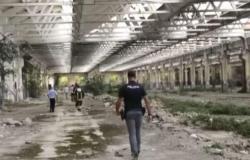Bari, 25 June 2024 – Homogeneous and more streamlined procedures for taking care of almost 3,400 frail users, especially elderly and disabled adults and minors, placed in over 140 facilities. A complex “puzzle” built around the needs of people in need of social and health assistance, to whom the Social and Health Service Area of the ASL Bari is called upon to provide adequate responses.
For some time now also through the simplified paths of the project called “Protocol of Administrative Procedures for Social Health Care”, the results of which were recently presented at the IV Italian Conference on Social Service Research “CIRSS” held in Lecce, at the University of Salento, with the large participation of social workers from the various working areas of the sector: healthcare companies, municipalities, third sector, ministries, universities, public and private entities with research projects and innovative experiments.
During the conference, Dr. Cinzia Mongelli (head of the Professional Social Service Office and co-coordinator of the project), at the invitation of the “Iris Socialia”-SUNAS Study Center, illustrated the functioning of the project. Which is first of all the result of a complex inter-company and multidisciplinary work, in which various offices and services collaborated (Districts, Departments, Territorial Services), under the “direction” of the Social and Health Service Area (Director Dr. A. Ilaria Zingaro), articulation of the Government of Healthcare Demand and Supply Department. Structures and professionals involved in the management, governance and monitoring of waiting lists for user access in over 140 public and private residential and semi-residential socio-health facilities, Homes for Life and Hospices active in the provincial territory.
How taking charge works
In 2019, the need arose to start a process of uniform definition of the administrative procedures for social and health care, also in light of the new Regional Regulations nos. 4 and 5 of 2019, with which the Puglia Region started the reprogramming of the socio-health sector, adapting the structural and organizational standards of the socio-health structures to the new national socio-health LEAs of 2017.
The Protocol, reviewed annually, is mainly a working tool that allows us to define, by networking them, the actors and roles of the process of taking charge, to regulate the relationships between company areas, structures and socio-health services, to define procedures and tasks , but above all to make the company processes for patient access to residential and semi-residential facilities homogeneous, facilitating the patient’s transition to other care settings.
The network of multidisciplinary skills
Within the Social and Health Area, in particular, the Professional Social Service – which guarantees professional support to the clinical – health sector – identifies the multiple needs, expressed and latent, of the population, especially those of people in fragile conditions and provides them concrete answers in full compliance with legally recognized rights and the assigned budget. The needs analysis phase is particularly crucial, as it directly involves the Department of Government of Healthcare Supply and Demand, the Territorial Assistance Department, the districts, managers and ASL operators (social workers, referring doctors of the multidimensional evaluation units – UVM, nurses professionals), and the professionals present in the Department of Mental Health, Department of Pathological Addictions and Department of Developmental Medicine. Indirectly, then, the process also calls into question the municipalities and operators of the territorial social areas, involved in the decision-making and operational phases of taking care of people in a state of complex socio-health need and in a condition of non-self-sufficiency.
The constant collaboration and interaction with the aforementioned services is also constantly guaranteed with the activation of multidisciplinary service conferences, with the participation of the Department of Mental Health, Department of Pathological AddictionsChild and Adolescent Neuropsychiatry and Districts, for the management of complex cases and the identification of the most appropriate response for patients’ needs.
At the same time, the administrative sector of the Social and Health Area operates, responsible for the administrative – liquidation management of the services provided by the social and health structures, following completion of the necessary checks and verifications required by current legislation, as well as the management of contractual relationships with them.
Facilities and patients: here are the numbers
There are 3,383 accredited places (for the same number of users) currently managed by the Socio-Health Area of the ASL Bari, distributed among 144 structures with operating authorization (necessary to activate the services) and accreditation (provided to guarantee quality of assistance and services ): essential criteria without which it is not possible for the ASL to commission the structures to provide social and healthcare services and, therefore, proceed with the contractualization of accredited places. The objective of this process, now made more fluid, is to guarantee citizens a service capable of satisfying their need for all-round assistance.
In detail, the ASL Bari, through the Social and Health Area, governs a system which includes 54 Social and Health Care Residences for the Elderly (RSSA) with places for maintenance and extensive Alzheimer’s assistance, 36 socio-educational and rehabilitation day centers and 17 Alzheimer’s day centers contracted for a total of 1,154 places. A further 1,730 places are available in total in 15 RSSAs for disabled adults with maintenance and extensive assistance places, 12 ” Dopo di Noi” structures, 6 Nursing Homes (RSAs) with ordinary places and Alzheimer’s places; the remaining places are distributed among those reserved for intensive Alzheimer’s care (229), 2 Hospices (50 places) and 19 Homes for Life (around 220 patients).
From the point of view of the age of the users in charge, people with disabilities aged between 18 and 64 enter the residential and semi-residential facilities, while four day centers welcome disabled people under the age of 18. The other facilities dedicated to the elderly can be accessed by those aged 64 and over and, for the most part, these are people who also require healthcare assistance. Finally, RSAs are facilities used by both young and elderly patients who need more intensive post-hospital social and healthcare assistance.





